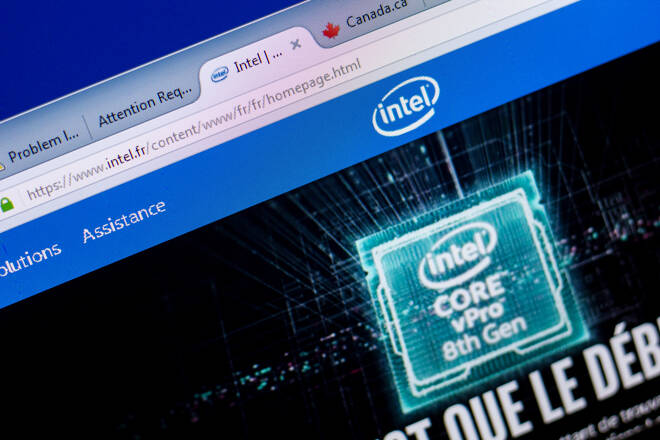Advertisement
Advertisement
Intel Struggling to Hold Deep Support
By:
The long-term pattern looks like a complex top that will eventually yield a steep bear market decline.
Dow component Intel Corp. (INTC) bounced in the mid-40s when Russia invaded Ukraine, marking the seventh bounce at this four-year support level. The chip giant has now booked zero returns except for dividends since 2017, a painful accomplishment for one of the largest tech operations in the world. Even so, the company’s massive investment in local fabrication could pay off, with international sources coming under political pressure.
Notebook Sales Slowing Down
Sadly, other divisions may underperform badly before those plants come on line in the next five years. Notebook sales mark the latest headwind, with Citi warning that February shipments were down 11% month-over-month, much worse than expectations for a 5% decline. Of course, low component inventories drove part of this shortfall but the broad PC market is clearly overbought after two years of double-digit growth and is overdue to a retrenchment.
Citi analyst Christopher Daley just issued a ‘Neutral’ rating and listed his concerns about 2022 notebook sales, stating that “We see notebook shipment weakness as another yellow flag after Intel stated it sees an inventory correction in the notebook end market during its last earnings call.” Morgan Stanley went a step further at the end of February, downgrading the stock to ’Underweight’ and cutting the price target from $55 to $47.
Wall Street and Technical Outlook
Wall Street consensus is downright dreary, with a ‘Hold’ rating based upon 7 ‘Buy’, 2 ‘Overweight’, 22 ‘Hold’, and 3 ‘Underweight’ recommendations. In addition, six analysts recommend that shareholders close positions and move to the sidelines. Price targets currently range from a low of $40 to a Street-high $70 while the stock is set to open Monday’s session more than $7 below the median $53 target. Sustained upside is unlikely in the short-term, given weak investor sentiment.
Intel topped out within six points of 2000’s all-time high in January 2020 and failed a breakout above resistance in the upper 50s during the pandemic decline. It then settled into a choppy trading range, with a horizontal floor in the mid-40s that was first crossed in 2017. The long-term pattern looks like a complex top that will eventually yield a steep bear market decline. The company is racing against time to avoid this fate through its massive expansion of US manufacturing capacity.
Catch up on the latest price action with our new ETF performance breakdown.
Disclosure: the author held no positions in aforementioned securities at the time of publication.
About the Author
Alan Farleyauthor
Alan Farley is the best-selling author of ‘The Master Swing Trader’ and market professional since the 1990s, with expertise in balance sheets, technical analysis, price action (tape reading), and broker performance.
Advertisement
